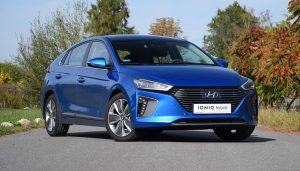
The Hyundai RN30 is maker's version of BMW’s M, Mercedes-Benz’s AMG, and similar high performance divisions from other automotive marques.
Hyundai RN30 Hints At Hot Hatch Coming Soon
The Hyundai RN30, the Korean automaker’s latest high-performance N concept, premiered at the 2016 Paris Motor Show. Based on the New Generation Hyundai i30, the RN30 was developed as an all-out racing car. It showcases a variety of technologies that showcase the coming N brand. This is Hyundai’s version of BMW’s M, Mercedes-Benz’s AMG, and similar high performance divisions from other automotive marques.
This effort is headed by Albert Biermann, whose title is Head of Vehicle Test & High Performance Development for Hyundai Motor. You may know him as the former head of BMW’s M division. This shows how serious Hyundai is about establishing legitimate performance credentials. In Biermann’s words, “Soon to evolve into our first N model, the RN30 is inspired by our passion to provide a high-performance car that everybody can enjoy effortlessly.”
The Skinny on the Hyundai RN30
All N models are developed in Namyang, South Korea. They are then extensively tested at the Nürburgring race track. The N logo represents the chicane of a race track.
Plenty Of Power
The Hyundai RN30’s power is supplied by a 2.0-liter turbocharged engine. A larger turbo increases power at full throttle. To manage this additional power, the engine block has been strengthened through the use of forged instead of cast parts to increase its durability. As a result, the RN30 boasts 375 hp and a maximum torque of 333 ft.-lb.
Managing all this torque is a wet-type dual-clutch transmission. To manage the car’s power, the RN30 is equipped with an all-wheel drive system. Other technologies that enhance safety and control include an electronic limited-slip differential system that makes sure each wheel receives sufficient torque. This helps prevent skidding and ensures fast, precise cornering at high-speeds.
Special Efforts at Lightweighting
When developing the Hyundai RN30, Hyundai’s designers and engineers established a new approach to reducing weight and lowering the center of gravity. Instead of using the carbon fiber material common to most high-performance cars, Hyundai is using all-new high-performance plastic materials, developed in collaboration with chemical company BASF. These new materials are light, highly durable and environmentally friendly.
Inside, redundant parts were removed and heavier parts sit in the lowest possible position. The center of gravity is lowered further by pushing back and lowering the seats.
Hyundai RN30 Exterior Form Follows Function
The shape of the RN30 is based on the new Hyundai i30, but with a lower, wider stance. The width of the RN30 has been increased by 30mm compared to the i30 and height has been lowered by 84mm. A ‘floating’ fender over each wheel works with the side splitters to improve aerodynamic downforce. The airflow from the front to the rear passes through the mesh radiator grill and the air intake, improving downforce and optimizing engine cooling.
The large rear spoiler generates downforce during high-speed driving. A central roof fin adds stability. For optimal and balanced downforce, the car features a large rear diffuser set above centrally-mounted white ceramic twin exhaust pipes.
Interior Optimized For Performance Driving
RN30 designers and racing experts from Hyundai Motorsport worked together closely. A bucket seat and an integrated roll cage support and protect the driver.
To capture the driver’s reactions and dynamic moments while on the road or track, cameras are attached inside each A pillar, with an outside camera attached to the center fin on the roof. Drivers can use this system to create professional-looking racing footage.
The Hyundai RN30 is the latest in a succession of high-performance sports concepts that point towards the future of N production models. The i30N model will be available next year. Hyundai promises that it will make high-performance driving accessible to everyone.
How Much Of The RN30 Will Be In The i30N?
As with most auto show concepts, you can strip away the over-the-top features and extravagances to find the bones of the production car underneath. Remove the extreme bodywork, the dihedral doors, the racing cockpit, and the oversize wheels and tires. What we are likely to end up with is a competitor to the Ford Focus RS, Subaru WRX STI and the coming Civic Type R. That’s not a bad thing at all – and in the fine Hyundai tradition, it may also undercut them on price!





